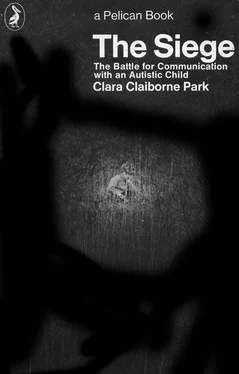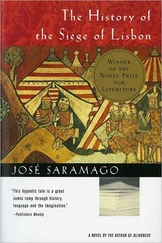It was as if, then, Elly had realized early, earlier than it seems possible for any child to realize, that if she remained motionless, sitting on a rug in the middle on the floor, nothing could occur to threaten her, that if she attempted to do nothing, she need never fail. She did not in fact sit motionless — she was alive and healthy, her body functioned and impelled her to a fuller interaction with the world than that — but it seemed to us that this was the model of her condition. Her body was as strong as it was beautiful, but in comparison to a normal child she used it hardly at all. The first strategies of the besiegers must deal with this least abstract, most accessible of Elly’s weaknesses. It was useless to assault ears that would not hear us and eyes that would not see. The first approach — the only way in — was to try to return to her her primary birthright, the use of her body.
How elevated that sounds, how elaborate and complex! Yet it is a fancy description of something most simple. There can be nothing esoteric about a mother working with a baby, trying tactfully, delicately, to encourage it to do new things. This is what all mothers learn. Everything I found to do in this abnormal, extreme situation was only an extension and intensification of things I had done with my normal babies. Such tact as I had I had learned with them. So it may be with a feeling of anticlimax that the reader moves into a description of what was actually done. It seems very simple and it was. There wasn’t anything else for it to be. Even the most accomplished professional therapists of children, if we view them operationally, considering what they do, do something quite simple. They discover the right games to play.
Consider one of the first skills we managed to convey to her — drinking from a cup. She sat with us at the table, she fed herself, but although her cup was there before her, small and comfortably available, she never picked it up. When it was time to drink I held it up for her, as I had done ever since she was a small baby. If I put it in contact with her fingers they refused even to close around it, let alone expend the force necessary to lift it to her mouth. Months went by — she was twenty months old, two years, and still incapable of grasping the cup. Incapable at table. In her bath she had cups which she used with finesse, not only picking them up but deftly pouring water from one into the other. More months pass. It is late in November; Elly, born in July, is nearly two and a half.
One day at dinner Elly surprises us. Rapidly, decisively, she picks up a small glass of milk, pours it accurately into her apple sauce. There is a precedent; the previous day I had poured milk into her apple sauce for the first time, but that hardly explains it. Though man is an imitative animal, Elly does not imitate. Nevertheless, some resistance seems to be giving here; the very next day she picks up one of her bath cups and drinks from it. The day after, she picks up her cereal bowl, quickly drinks some of the milk, and pours the rest on the table.
There was so little at any given time going on with Elly that it took no special acumen to note a new readiness, which could perhaps be made use of. Experience had taught me that while other babies might be encouraged if congratulated and made a fuss over, Elly would react in just the opposite way, with retreat. It worked badly when we called attention to anything Elly was doing — she always stopped doing it. As if she didn’t want to be committed to any forward progress — as if she feared that any concession she made would at once be taken advantage of. I knew the new skill was best ignored, not pressed.
So I got a very tiny cup, much smaller than her small child’s mug — so small, so inconspicuous that it would be hard indeed to regard it as a challenge. I filled it with Elly’s favourite juice. But half full only. With her uncanny accuracy she wasn’t likely to spill even a full glass, but I wanted to eliminate the slightest threat of failure. I put the cup, not on the dinner table where her ability, if displayed, would be noted and seem formally to commit her, but on a low chair. It was not yet serving time and Elly was moving about the kitchen as usual. She spotted the little cup, and when she did pick it up and drink it none of us appeared to notice. Indeed it was easy not to, she did it so fast Above all, we did not at once set cup and juice at her place at table; we fed her her liquids exactly as before. Not for several days did I move the tiny cup from chair to table, and not for several more did the juice begin to appear in successively larger vessels. One must respect other people’s concessions, and recognize that they may have cost more than may appear. Even a tiny child has face to lose, and we guessed that Elly had much invested in her disabilities, although we did not, still do not, know what it was, and is.
It was the same with introducing her to new toys — and to extend Elly’s range of play seemed even more important than teaching her convenient household skills. My diary records Elly’s play activities at the time she returned from the hospital:
She is still playing primarily with rattles, which she likes to use as a tool for patting picture books. In fact exercising — joggling or rocking in chair or crib — chaining, and patting are all she does. She can be left alone on a bed for hours with no toys; she will not fall off or get down. Peg-in-hole toys or ring on peg she regards only as something to dismantle, the parts of which can then be used to pat or knock other surfaces.
I had tried to induce her to put rings on a stick before she went to the hospital. Had it been too soon, or had I merely not seen how it should be done? When she came back I thought harder. I got down on the floor, close beside Elly. I did not push the toy into her radius of attention. I began to play with it myself. In slow motion I put on several of the bigger, harder rings. Then I put on a smaller ring, but only halfway. Askew, yet clearly on, even Elly couldn’t consider it too difficult a challenge, and what I was doing was something more interesting than what she was doing, which was, as usual, nothing. I retreated a hand’s breadth and looked away. When I looked back, the ring was on the stick.
More of this, and then I could risk extending it. Perhaps Elly was ready for me actually to give her the smallest, easiest ring. I didn’t put it into her hand — Elly never accepted objects as directly as that. Instead I laid it on the floor beside her hand. And she picked it up and she put it on the stick.
The next day she put all the rings on the stick, easily, neatly, as if she had always been able to. Soon — I can’t remember when — she learned of herself to arrange them according to size, one of the earliest indications of something we were to become more and more familiar with, the extraordinary sense of order of the autistic child — the sense, perhaps, which made it necessary for her to adjust that first ring, left, by a lucky intuition, halfway on.
How hard it is to keep this account from taking on the tone of a success story. For what had I accomplished? In addition to book-patting, chaining, and rocking, Elly could now put rings on a stick. As if in relief at the introduction of some variety into her circumscribed activities, she did put rings on a stick — over and over and over. With each of the few activities I was able to add it was the same — received with delight at first, it was repeated and repeated and finally abandoned as if — as if — in boredom. She would not extend it into meaningful play, and I could find no way of helping her. Blocks were to tower, then to line up parallel, but never to build a house. Indeed at that time I had no reason to think that Elly knew what a house was, that she knew what anything was except perhaps the food she ate and the clothes she wore. It is necessary to emphasize that this account is not to be read like an account of a normal child in which the description of one activity does duty for a whole class. In describing Elly at two I do not have to select. What I tell is all there is to be told.
Читать дальше












